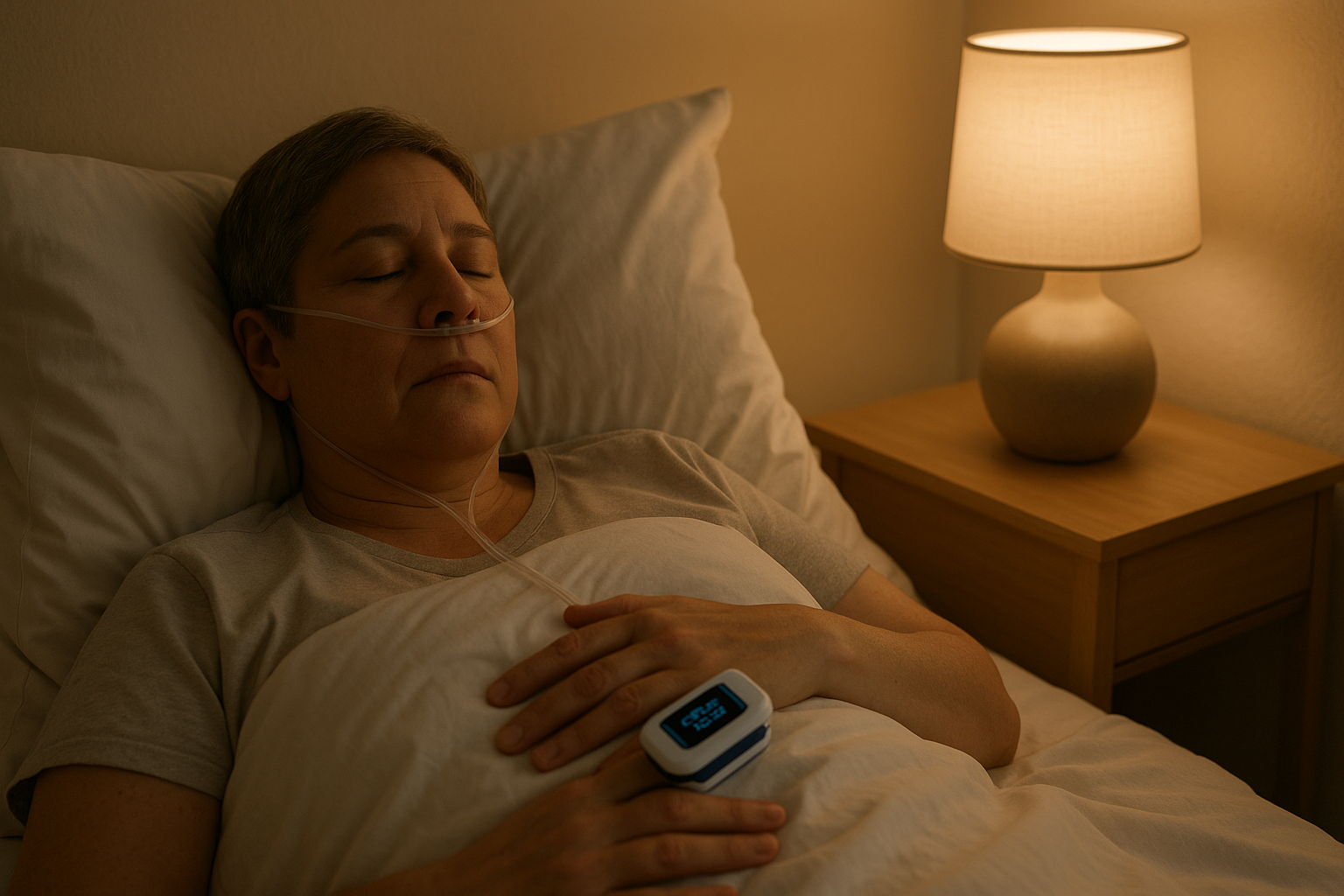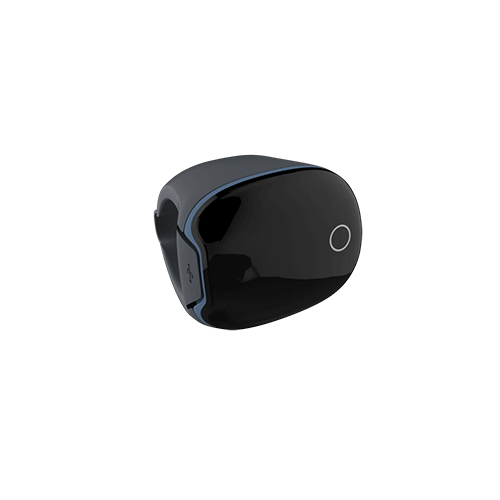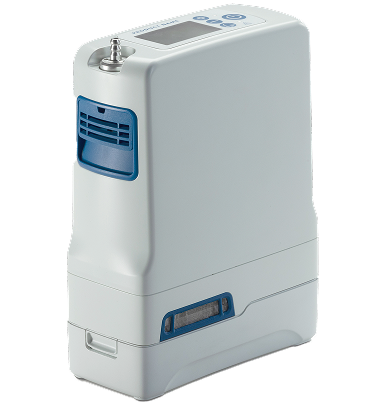Nighttime oxygen drops in COPD are common and dangerous, often going unnoticed. These drops, known as nocturnal desaturation, occur when blood oxygen levels fall below 88% for more than 5 minutes during sleep. This can lead to serious complications like pulmonary hypertension, heart issues, and poor sleep quality.
Key Points:
- Symptoms to Watch For: Morning headaches, daytime fatigue, frequent awakenings, cyanosis (bluish skin/lips), rapid breathing, and confusion.
- Causes: Relaxed respiratory muscles during sleep, REM sleep challenges, and conditions like sleep apnea or obesity.
- Risks: 27%-70% of COPD patients experience nocturnal oxygen drops, even those with normal daytime levels.
- Solutions: Overnight pulse oximetry for monitoring, oxygen therapy, CPAP for sleep apnea, and lifestyle changes.
Early detection and treatment are critical to prevent long-term health problems. Monitoring tools like pulse oximeters and treatments like supplemental oxygen can improve life quality and reduce risks.
Warning Signs of Nighttime Oxygen Drops
Main Symptoms to Look For
Spotting the signs of nighttime oxygen drops can be tricky since they often develop slowly while you're asleep. Still, there are several symptoms that could point to falling oxygen levels during the night.
One of the earliest indicators is morning headaches. When oxygen levels dip during sleep, blood vessels in the brain can dilate, leading to headaches that usually ease as the day progresses.
Another common signal is daytime fatigue. If your body isn’t getting enough oxygen at night, you might feel unusually tired or drained during the day, even after a seemingly full night's sleep.
Frequent nighttime awakenings could also be a red flag. You might wake up gasping for air, choking, or even experiencing a racing heart or a sudden sense of anxiety.
Physical signs to watch for include bluish discoloration of the skin, lips, or fingernails (known as cyanosis), which calls for immediate medical attention. You might also notice rapid breathing or an increased heart rate when you wake up.
"Hypoxemia can be a life-threatening condition, but it's treatable with prompt medical attention. It can also happen intermittently without obvious symptoms - for instance overnight, if you have sleep apnea. This can cause damage to your heart over time, so it's important to know your risk and what preventative measures you can take." – Cleveland Clinic [4]
Other respiratory symptoms might include wheezing, increased coughing at night, or trouble speaking full sentences upon waking. Changes in mucus production or needing your rescue inhaler more often could also be signs.
You might also notice cognitive symptoms, like confusion, memory issues, or trouble concentrating. These are often most noticeable in the morning and tend to improve as oxygen levels stabilize.
Research shows that over 75% of people with COPD report nighttime symptoms, and 78.1% have experienced some degree of sleep disruption [5]. These symptoms not only interfere with sleep but can lead to more serious health problems if left unchecked.
Health Problems from Untreated Low Oxygen at Night
Failing to address nighttime oxygen drops can result in serious, long-term health complications that go far beyond just poor sleep.
One major concern is pulmonary hypertension. When oxygen levels drop repeatedly, the heart works overtime to pump blood, which can increase pressure in the pulmonary arteries. Over time, this strain may lead to right-sided heart failure.
Cardiovascular issues are another risk. Low oxygen levels during sleep can trigger dangerous heart rhythm abnormalities (arrhythmias) and, over time, cause lasting damage to the heart.
Here’s a quick look at the short- and long-term effects of untreated nocturnal oxygen drops:
| Acute Effects | Chronic Effects |
|---|---|
| Heart rhythm abnormalities during severe drops | Increased risk of long-term heart damage |
| Elevated pulmonary artery pressure during sleep | Development of right-sided heart failure |
| Sleep structure disruption | Persistent poor sleep quality in severe COPD |
Untreated nighttime oxygen drops can also make COPD symptoms worse. You might notice increased shortness of breath during the day, more frequent exacerbations, and a faster decline in lung function.
Poor oxygen levels at night disrupt your sleep patterns, creating a vicious cycle of poor sleep, daytime fatigue, and reduced physical activity, all of which can worsen COPD symptoms.
Alarmingly, research highlights that deaths during COPD exacerbations tend to occur more often at night [7]. While stable conditions might not always link directly to nocturnal oxygen drops, the risks during sleep remain high.
Chronic oxygen deprivation at night can also impact your brain, potentially leading to memory problems, trouble concentrating, and difficulties with decision-making over time.
If you notice symptoms like confusion, shortness of breath, a rapid heartbeat, or bluish discoloration of your nails, lips, or skin, seek medical help immediately [4].
Catching these warning signs early and getting the right medical care can help prevent complications and improve how you manage your COPD.
What Causes Nighttime Oxygen Drops in COPD
How Oxygen Drops Happen During Sleep
To understand why oxygen levels drop at night in people with COPD, it’s important to look at how sleep naturally affects breathing. During sleep, the effort to breathe decreases, with minute ventilation dropping by 16% during non-REM sleep and as much as 32% during REM sleep in COPD patients [8]. While this is harmless for healthy individuals, it can cause significant oxygen desaturation in those with COPD.
"Sleep in chronic obstructive pulmonary disease (COPD) is commonly associated with oxygen desaturation, which may exceed the degree of desaturation during maximum exercise, both subjectively and objectively impairing sleep quality." - Walter T McNicholas et al. [6]
REM sleep presents a particular challenge because, during this stage, breathing relies almost entirely on the diaphragm. The intercostal and accessory muscles, which assist with breathing, are mostly inactive [7]. For COPD patients, whose diaphragms are often weakened due to lung hyperinflation, this situation can lead to significant oxygen drops. Hypoventilation, or shallow and slow breathing, is the main culprit behind these REM-related oxygen dips [7]. Additionally, a reduced functional residual capacity during sleep worsens the mismatch between ventilation and blood flow in the lungs, further lowering oxygen levels [6].
For individuals with already low daytime oxygen saturation - especially those whose levels hover below 93% on the oxygen-hemoglobin dissociation curve - even small decreases in oxygen can result in disproportionately large drops in blood oxygen levels [6]. On top of these mechanisms, other factors like increased airway resistance during sleep and a reduced response to rising carbon dioxide levels contribute to nocturnal oxygen drops [6]. These physiological changes create a complex backdrop where personal risk factors can make the problem even worse.
Factors That Increase Your Risk
Certain factors can heighten the risk or severity of nighttime oxygen drops in COPD patients.
Daytime oxygen saturation plays a critical role. Studies show that up to 70% of COPD patients with daytime oxygen levels between 90% and 95% experience nocturnal hypoxemia [8]. If your oxygen levels are borderline during the day, nighttime drops are almost a given.
The "overlap syndrome", where COPD and obstructive sleep apnea (OSA) coexist, is an especially dangerous condition. While overlap syndrome affects about 1% of the general adult population, it’s more common in COPD patients and leads to more severe nocturnal oxygen desaturation [8].
"Overlap patients develop more pronounced nocturnal oxygen desaturation (NOD) than COPD or OSAS alone, which predisposes to pulmonary hypertension." - Walter T. McNicholas [9]
Obesity is another significant factor. It not only makes breathing harder during sleep but also increases the likelihood of sleep apnea. Research has identified body mass index (BMI) as one of the strongest predictors of sleep hypoventilation severity in COPD patients [8]. Similarly, individuals with elevated daytime carbon dioxide levels (hypercapnic COPD) are at greater risk for severe nighttime breathing issues, with 43% of hypercapnic COPD patients without sleep apnea developing sleep hypoventilation [8]. Spending more time in REM sleep, the most challenging stage for breathing, also raises the risk [8].
Physical changes linked to COPD, such as fluid retention that shifts to the neck area when lying down, can further narrow the airway and worsen breathing problems [6].
These combined factors explain why some COPD patients experience severe oxygen drops at night while others with similar daytime lung function remain more stable. Identifying your specific risk factors can help determine whether overnight monitoring might be a valuable tool in managing your condition.
Using Overnight Pulse Oximetry to Find Nighttime Oxygen Drops
How Pulse Oximeters Work
Pulse oximeters use light to measure your blood oxygen levels in a noninvasive way. By shining light through a part of your body, like your finger, they analyze how much light is absorbed to determine the amount of oxygen in your blood. This works because oxygenated and deoxygenated blood absorb light differently. When used overnight, these devices continuously monitor your oxygen levels and provide key data, including:
- Mean overall saturation: Your average oxygen level throughout the night.
- Lowest recorded saturation: The lowest point your oxygen levels reached.
- T-90: The total time spent with oxygen levels below 90%.
- Oxygen desaturation index (ODI): How often your oxygen levels drop by at least 4% per hour.
For most healthy people, overnight oxygen saturation averages around 96% [3]. This kind of detailed tracking is essential for spotting small but important changes in oxygen levels while you sleep.
Why Overnight Monitoring Helps
Overnight monitoring is crucial because oxygen drops during sleep often happen without noticeable symptoms. By tracking oxygen levels throughout the night, healthcare providers can identify when these drops occur and how severe they are. This data helps distinguish between oxygen issues caused by conditions like COPD and those linked to other sleep-related breathing problems. It also allows doctors to fine-tune treatments, such as supplemental oxygen therapy, without requiring frequent visits to a sleep lab.
Additionally, overnight pulse oximetry offers a practical and affordable way to screen for nocturnal oxygen problems, known as hypoxemia [3]. It’s a valuable tool for evaluating how well treatments are working and for guiding decisions about care.
Monitoring Tools We Recommend
When choosing a pulse oximeter for overnight use, look for devices with a long battery life, a secure and comfortable fit, and features that make overnight monitoring easy. Rechargeable batteries and automatic shut-off features can add convenience, while accuracy within 2% and FDA clearance ensure reliable results.
Many people prefer wearable, ring-style oximeters that pair with smartphone apps for easy data review. Others opt for traditional fingertip models with bright displays that fit various finger sizes. Here are a few options to consider:
- Wellue Wearable Oxygen Monitor: Designed for extended use, priced around $180.
- Zacurate Pro Series 500DL: Offers quick, clear readings for about $23.
- Insignia Pulse Oximeter: Features adjustable brightness to reduce sleep disruption.
Additional features like plethysmograph waveforms, perfusion index readings, or onboard data storage can provide even more insight into your overnight oxygen patterns. Selecting a device that is simple to use and comfortable for nightly wear will ensure consistent and reliable monitoring - especially if you travel often [10].
sbb-itb-3e96dba
How to Treat Nighttime Oxygen Drops in COPD
Medical Treatments
Supplemental oxygen therapy is one of the most common approaches for managing nighttime oxygen drops in people with COPD. This involves using an oxygen concentrator or tank during sleep to maintain safe oxygen levels. Research shows that using nocturnal oxygen therapy for 12 hours a night can improve survival rates [2]. Doctors usually recommend this therapy when nighttime oxygen levels repeatedly fall below safe limits, even if daytime levels are stable. This is because low oxygen levels during sleep often signal the need for additional oxygen support.
For COPD patients who also have obstructive sleep apnea, Continuous Positive Airway Pressure (CPAP) therapy can be highly effective. CPAP works by delivering a steady stream of air through a mask to keep the airways open during sleep, reducing the risk of airway collapse [11]. Regular follow-ups with your doctor and occasional overnight pulse oximetry tests are essential to ensure these treatments are working as intended.
Lifestyle Changes That Help
Certain dietary supplements, such as magnesium, omega‑3 fatty acids, and vitamin D, may support lung health. Always consult your doctor before adding these to your routine.
Comparing Different Treatment Options
Here’s a quick breakdown of treatment options, along with their benefits, drawbacks, and who they’re best suited for:
| Treatment Option | Benefits | Drawbacks | Best For |
|---|---|---|---|
| Oxygen Therapy | Boosts blood oxygen levels; improves survival rates; available around the clock | Requires equipment; limits mobility; ongoing expenses | Patients with persistent low oxygen levels |
| CPAP Therapy | Helps manage sleep apnea; improves sleep quality; prevents airway collapse | Can be uncomfortable; requires adaptation; not ideal for oxygen-only issues | COPD patients with obstructive sleep apnea |
| Portable Oxygen Concentrators | Easy to travel with; no refills needed; quiet operation | Higher initial cost; limited oxygen flow; battery-dependent | Active individuals who frequently travel |
| Liquid Oxygen Systems | High oxygen flow; portable and lightweight; longer use time | Expensive; regular deliveries needed; risk of evaporation | Patients needing high oxygen flow rates |
For those managing COPD at home, devices like portable oxygen concentrators and pulse oximeters can make a big difference. COPD Essentials offers a range of tools designed to support your care.
Often, the best results come from combining multiple therapies. For example, a blinded exercise test can help determine if oxygen therapy is beneficial for exertional hypoxemia. If no improvement is observed, it’s worth revisiting the treatment plan [2]. Research also suggests that continuous oxygen therapy is more effective than using it only at night, as it improves survival rates and reduces strain on the pulmonary system [12]. Collaborating with your healthcare team to create a personalized, goal-focused treatment strategy is crucial for long-term success.
Nocturnal Hypoxemia
Why Early Detection and Treatment Matter
Spotting nocturnal oxygen drops early can make a huge difference in health outcomes and overall quality of life. Many COPD patients experience oxygen dips during sleep, even when their daytime levels seem normal[1].
If left untreated, these nighttime drops can lead to serious issues like respiratory failure, more frequent flare-ups, poor sleep, pulmonary hypertension, and even increased mortality. For those with overlap syndrome, the risk is even higher - mortality rates jump to 42.2% compared to 24.2% in those without it[6].
Catching these oxygen drops early allows for timely, targeted treatments, such as supplemental oxygen therapy. This helps prevent complications like pulmonary hypertension and cor pulmonale[14]. It’s a proactive step that not only reduces medical risks but also improves daily life.
Addressing nocturnal oxygen issues can also lead to better sleep and improved alertness during the day. Sleep disturbances affect 30%–70% of COPD patients, often leaving them drained and unfocused[15][30][31].
Overnight pulse oximetry, offered through COPD Essentials, is a useful tool for detecting these oxygen drops early. Healthcare providers often recommend it for COPD patients with daytime oxygen saturation below 93% to help avoid severe complications[15].
Regular monitoring and check-ups with specialists are key to catching oxygen fluctuations before they cause lasting damage. This ongoing attention is a cornerstone of effective COPD management[13].
FAQs
Nocturnal oxygen desaturation in COPD can happen without you even realizing it while you sleep. One effective way to identify this is through overnight pulse oximetry, a tool that keeps track of your oxygen levels throughout the night. Key signs to watch for include oxygen saturation dropping below 90% for a long stretch or staying under 90% for over 10% of the total monitoring time.
If you think you might be experiencing nocturnal oxygen desaturation, it’s important to discuss it with your healthcare provider. They can guide you on testing and possible management strategies. Devices like pulse oximeters are also handy for keeping an eye on your oxygen levels at home, offering useful insights into your nighttime health.
Overnight pulse oximetry serves as a straightforward yet powerful method to spot episodes of low oxygen levels (hypoxemia) in COPD patients during sleep. By catching these dips early, healthcare professionals can fine-tune oxygen therapy to better suit each patient’s specific needs, improving nighttime oxygen levels and overall care.
This type of monitoring can also help identify potential COPD flare-ups and guide more personalized treatment strategies, leading to better day-to-day well-being for those managing the condition.
Managing nighttime oxygen dips in COPD can often be addressed with a few straightforward adjustments. One of the most impactful changes? Quitting smoking. It’s a game-changer for preserving lung function and improving overall respiratory health. Staying active and maintaining a healthy weight can also make a noticeable difference in breathing and oxygen levels.
Your sleep position matters too. Using a wedge pillow or sleeping slightly reclined can help ease nighttime shortness of breath. In some cases, supplemental oxygen therapy during sleep might be recommended to keep oxygen levels steady. Adding breathing exercises, like pursed-lip breathing, to your routine can also promote better oxygen flow and make nights more comfortable.
As always, it’s important to work with your healthcare provider to find the best approach tailored to your needs.









